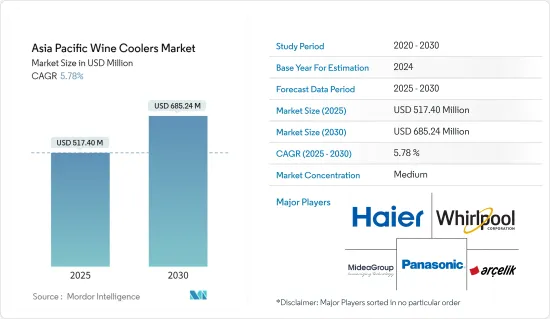 |
市场调查报告书
商品编码
1636184
亚太地区酒柜:市场占有率分析、产业趋势与成长预测(2025-2030 年)Asia Pacific Wine Coolers - Market Share Analysis, Industry Trends & Statistics, Growth Forecasts (2025 - 2030) |
||||||
※ 本网页内容可能与最新版本有所差异。详细情况请与我们联繫。
亚太地区酒柜市场规模预计到2025年为5.174亿美元,预计到2030年将达到6.8524亿美元,预测期内(2025-2030年)复合年增长率为5.78%。

亚太地区酒精消费量较高,预计将推动酒柜市场的成长。具体来说,私营部门对酒柜的需求不断增长。随着消费者越来越多地选择进口葡萄酒,酒柜的需求量很大,这凸显了保持葡萄酒凉爽和无菌的必要性。值得注意的是,特别受年轻人欢迎的葡萄酒市场将在未来几年大幅成长。与其他烈酒相比,年轻一代更喜欢葡萄酒的甜味,进一步推动了这种快速增长,这表明酒柜的未来充满希望。
葡萄酒对年轻人的吸引力、先进葡萄酒保存解决方案的可用性以及葡萄酒对健康的益处(例如降低胆固醇和维护心臟健康)都进一步推动了葡萄酒的消费。亚太地区在酒柜市场的主导地位是由于该地区可支配收入的增加以及对葡萄酒消费好处的日益认可。
亚太地区酒柜市场趋势
中国线上葡萄酒销售占市场主导地位
到目前为止,中国的电子商务市场一直以淘宝和天猫为主,但随着网路购物的发展,更加多元化的平台生态系统正在出现。品商红酒、酒宝王等以B2C模式经营酒类的专业企业在抢占细分市场方面取得了显着进展。他们的胜利可以追溯到他们的客製化产品选择、全面的描述和互动式客户评论功能。这种转变不仅反映了西方在中国都市区中日益增长的影响力,也反映了中国经济的进步和富裕中阶,这推动了酒柜的需求增加。中国在酒柜市场的主导地位是葡萄酒消费率上升以及人们对葡萄酒消费带来的健康益处日益重视的直接结果。
日本主导酒柜市场
日本人均葡萄酒消费量最高,超过中国、韩国等亚洲国家。据估计,有 4500 万日本人经常享用葡萄酒,其中红酒位居榜首。日本的葡萄酒业正在蓬勃发展。日本的新酒庄不断涌现,生产各种优质葡萄酒,从红酒、白酒到玫瑰酒和气泡酒。这种增长的主要原因是欧洲葡萄品种的采用和日本葡萄酒品质的提高。千禧世代越来越喜欢葡萄酒,认为这是一种别緻而精緻的选择,导致酒柜购买量激增。日本在酒柜市场的主导地位直接反映了其高葡萄酒消费量和对葡萄酒好处的日益认识。
亚太酒柜产业概况
亚太地区的酒柜市场较为分散。该报告涵盖了在亚太酒柜市场运营的主要国际公司。从市场占有率来看,目前该市场由少数大公司主导。然而,随着技术进步和产品创新,中小企业在市场上的份额正在增加。主导市场的主要企业有海尔集团公司、惠而浦、美的、松下和Arcelik。
其他好处:
- Excel 格式的市场预测 (ME) 表
- 3 个月分析师支持
目录
第一章简介
- 研究假设和市场定义
- 调查范围
第二章调查方法
第三章执行摘要
第四章市场动态
- 市场驱动因素
- 葡萄酒的成长推动市场成长
- 市场限制因素
- 酒柜高成本
- 市场机会
- 提高人们对红酒的认识和健康益处
- 波特五力分析
- 新进入者的威胁
- 买家/消费者的议价能力
- 供应商的议价能力
- 替代品的威胁
- 竞争公司之间敌对关係的强度
- COVID-19 对市场的影响
- 关于酒柜市场技术进步的见解
第五章市场区隔
- 按类型
- 独立式
- 檯面
- 内建
- 依技术
- 压缩机类型
- 热电
- 按用途
- 住宅
- 商业的
- 按分销管道
- 在线的
- 离线
第六章 竞争状况
- 市场集中度概览
- 公司简介
- Haier Group Corporation
- Whirlpool
- Midea
- Panasonic
- Arcelik
- Samsung
- LG Corporation
- Bosch
- Philips
- Electrolux
第七章 未来市场趋势
第八章 免责声明
The Asia Pacific Wine Coolers Market size is estimated at USD 517.40 million in 2025, and is expected to reach USD 685.24 million by 2030, at a CAGR of 5.78% during the forecast period (2025-2030).

High alcohol consumption in the Asia-Pacific region is set to propel the growth of the wine cooler market. Specifically, there's a rising demand for wine coolers in the private sector. Consumers are increasingly opting for imported wines, emphasizing the need to keep them chilled and germ-free, thus boosting the demand for wine coolers. Notably, the wine market, especially popular with the younger demographic, is poised for significant growth in the coming years. This surge is further fueled by the younger generation's preference for wine's sweeter taste over other spirits, indicating a promising future for wine coolers.
Factors like wine's appeal to the youth, the availability of advanced wine preservation solutions, and the well-documented health benefits of wine, such as cholesterol reduction and heart health maintenance, are further propelling its consumption. The dominance of Asia Pacific in the wine cooler market can be attributed to the region's rising disposable incomes and the increasingly recognized benefits of wine consumption.
Asia Pacific Wine Coolers Market Trends
Online Wine Sales in China is Dominating the Market
While Taobao and Tmall have historically been the giants of China's e-commerce realm, the evolving online shopping landscape is witnessing the emergence of a more diversified platform ecosystem. Specialized players such as Pinshanghongjiu and Jiubaowang, with a singular focus on alcohol and a B2C operational model, are making notable strides in capturing their market segment. Their triumphs can be traced back to their tailored product selections, comprehensive descriptions, and interactive customer review features. This shift not only mirrors the growing Western influence in China's urban hubs but also highlights the nation's economic advancements and the expanding cohort of its affluent middle class, which is fueling a heightened demand for wine coolers. China's dominance in the wine cooler market is a direct consequence of its escalating wine consumption rates and the increasing appreciation for the health benefits associated with wine consumption.
Japan is Dominating the Wine Coolers Market
Japan outshines its Asian counterparts, like China and South Korea, with its higher per capita wine consumption. An estimated 45 million Japanese regularly indulge in wine, with red wine emerging as the top choice. The local wine scene in Japan is not just thriving but booming. The nation is witnessing a surge in new wineries, churning out a diverse range of high-quality wines, from reds and whites to roses and sparklings. This growth is largely attributed to the adoption of European grape varieties, elevating the quality of Japanese wines. Millennials, recognizing wine as a chic and refined option, are increasingly embracing it, leading to a surge in wine cooler purchases. Japan's dominance in the wine cooler market is a direct reflection of its high wine consumption and the growing recognition of wine's benefits.
Asia Pacific Wine Coolers Industry Overview
The Asia Pacific Wine Coolers Market is fragmented. This report covers the major international players operating in the Asia Pacific Wine Coolers Market. In terms of market share, a few large companies currently dominate the market. However, with technological advances and product innovations, small and medium-sized enterprises are increasing their market presence. The major players dominating the market are Haier Group Corporation, Whirlpool, Midea, Panasonic, and Arcelik.
Additional Benefits:
- The market estimate (ME) sheet in Excel format
- 3 months of analyst support
TABLE OF CONTENTS
1 INTRODUCTION
- 1.1 Study Assumptions & Market Definition
- 1.2 Scope of the Study
2 RESEARCH METHODOLOGY
3 EXECUTIVE SUMMARY
4 MARKET DYNAMICS
- 4.1 Market Drivers
- 4.1.1 Increase in Wine is Driving the Growth of the Market
- 4.2 Market Restraints
- 4.2.1 High Cost of Wine Coolers
- 4.3 Market Opportunities
- 4.3.1 Rise in Health Benefits & Awareness about Red Wine
- 4.4 Porter's Five Forces Analysis
- 4.4.1 Threat of New Entrants
- 4.4.2 Bargaining Power of Buyers/Consumers
- 4.4.3 Bargaining Power of Suppliers
- 4.4.4 Threat of Substitute Products
- 4.4.5 Intensity of Competitive Rivalry
- 4.5 Impact of COVID-19 on the market
- 4.6 Insights on Technological Advancements in the Wine Coolers Market
5 MARKET SEGMENTATION
- 5.1 By Type
- 5.1.1 Free Standing
- 5.1.2 Counter-Top
- 5.1.3 Built-In
- 5.2 By Technology
- 5.2.1 Compressor based
- 5.2.2 Thermoelectric based
- 5.3 By Application
- 5.3.1 Residential
- 5.3.2 Commercial
- 5.4 By Distribution Channel
- 5.4.1 Online
- 5.4.2 Offline
6 COMPETITIVE LANDSCAPE
- 6.1 Market Concentration Overview
- 6.2 Company Profiles
- 6.2.1 Haier Group Corporation
- 6.2.2 Whirlpool
- 6.2.3 Midea
- 6.2.4 Panasonic
- 6.2.5 Arcelik
- 6.2.6 Samsung
- 6.2.7 LG Corporation
- 6.2.8 Bosch
- 6.2.9 Philips
- 6.2.10 Electrolux*










